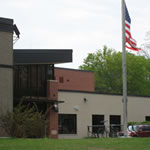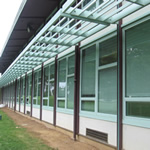
Making long-existing structures technologically up-to-date is a challenge, but it can be done.

School administrators walk a tightrope, balancing their desire for a green campus with the need for an acceptable ROI. Here are three examples of how campuses strike that balance — or, in one case, not worry about it at all.
Green, CHIPS, LEED, net zero, carbon neutral — what does it all mean?

The University of Alabama at Birmingham ranks high in ride-sharing.

Save Money and Conserve Natural Resources for Educational Facilities

Doing it right can save money and please the district and community.

Here's how two campuses are satisfying administrators by saving money and satisfying students by increasing sustainability in their restroom and locker room renovations.
Using facilities technology as a teaching tool.
Thoughts about the silent consumption of energy on campus.
Energy-efficient propane can help schools be and save green.
Wesleyan University’s student-designed permaculture garden blooms to life.
How Seattle's Bertschi School expansion became the fourth "Living Building" in the world.

Creating a sustainable building envelope can be complicated, but worth it. Think about today and tomorrow. Educational institutions need to plan for sustainable management of their built assets both now and in the future. Building envelopes are part of that effort.
So what is the solution to IEQ factors, acoustics, daylighting, thermal control, air quality and the effect each of these places on the other? The short answer is proper planning and coordination.
Something old, something new? That may work great in weddings, but how about campus renovations? In constructing new buildings, assuring good indoor environmental quality (IEQ) is a basic consideration. But when it comes to renovating older facilities, special efforts must often be taken to apply modern standards in acoustics, daylighting, thermal comfort, and air quality.
Edison Technical High School was originally founded in 1906, just 21 years after Fresno, Calif., was incorporated as a city in 1885. Those who had originally traveled to central California in search of gold and adventure found the regions soil rich
As architects and designers we are uniquely able to incorporate sustainable strategies into all of our projects, regardless of whether or not the project will be filed to achieve third-party certification. Sustainable strategies can be incorporated into any project through passive strategies, mechanical systems, and finish and furniture selection.
Reducing energy consumption is hugely beneficial, and nearly everyone is practicing good kW-cutting habits. But the second most direct route to decreasing energy costs is often overlooked: managing the energy purchase itself. The largest barrier to purchasing energy at lower prices: understanding the deregulated energy markets.
Sure, it’s easy to toss trash into the proper receptacles and to turn off the lights when leaving a room, but how does a university with thousands of personnel, administrators, and students on campus initiate a greener place to live, work, and study? Green initiatives for the higher education sector are everywhere, and there are so many ways that colleges can get involved, from implementing cleaner technologies that use less power consumption to offering vegan dining choices in the cafeteria to properly disposing of old, outdated printers.
Beyond the prospect for energy savings, many school boards assume there will be additional costs associated with green buildings, including the LEED certification effort and the associated building materials and mechanical, electrical and plumbing systems
Both security and sustainability are important. Newtown and other school shootings make the case for security. The case for sustainability is strong, too. Estimates say that buildings produce 35 percent of the carbon dioxide emitted in the U.S. and use 37
While the nonstop, point-grabbing treasure hunt for Silver, Gold, or even Platinum certification has forced architects to get better at designing and creating more efficient structures, everything outside the building envelope has basically remained an afterthought. This narrow approach not only downplays the complex role a project’s site plays in its overall sustainability, it also ignores cultural and contextual considerations that are critically important to campus planning and design. Thankfully, there could be help on the horizon with the long-overdue introduction of the Sustainable Sites Initiative (SITES) into the certification game.
Carbon neutrality, net-zero, whatever you call it, is going to be the way everybody will judge the success of sustainability strategies for school districts. Schools are public institutions by their very nature, and the public more and more desires that i
Unity College in central Maine is a small liberal arts college with a big voice in the national sustainability conversation. We take seriously our leadership role in higher education and across sectors, preparing our students for leadership roles of their own in a changing world. From our unique sustainability science focus throughout the curriculum, to our first-in-the-nation commitment to divest our endowment from fossil fuels, we aim to model viable approaches to sustainability education that improve learning, engage the community, and decrease environmental impact.
The Center for Green Schools at the U.S. Green Building Council was established to educate and change our schools into sustainable and healthy places. We believe that everyone should have the opportunity to learn in an environment that enhances the educat
Higher education has already taken a leadership role in climate mitigation — that is, preventing climate change by reducing greenhouse gas emissions — as displayed by the 660 signatory campuses of the American College & University Presidents’ Climate Commitment (ACUPCC) who have collectively reduced net carbon emissions by 25 percent in just five years. Now, higher education must take the lead in climate adaptation — preparing for and responding to the impacts of climate change.